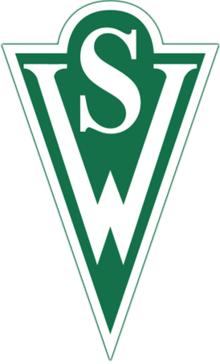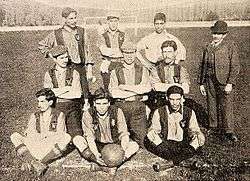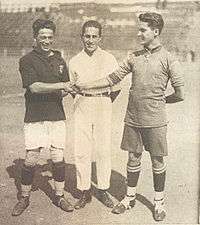Santiago Wanderers
 | |||
| Full name | Club de Deportes Santiago Wanderers | ||
|---|---|---|---|
| Nickname(s) |
Caturros (Cockatiels) Porteños (Harbour Men) El Decano (The Dean) | ||
| Founded | 15 August 1892 | ||
| Ground |
Estadio Elías Figueroa Brander Valparaíso, Chile | ||
| Capacity | 23,000 | ||
| Chairman |
| ||
| Manager |
| ||
| League | Campeonato Nacional | ||
| 2014–15 | Overall: 3rd | ||
| Website | Club home page | ||
|
| |||
Club de Deportes Santiago Wanderers are a football club in Valparaíso, Chile, which plays in the Campeonato Nacional, the first tier of the Chilean Football Federation. Founded on 15 August 1892, it’s the country’s oldest club as well as one of the four oldest football teams at Latin America alongside the Argentine clubs Gimnasia La Plata, Quilmes AC and Rosario Central, established between 1887 and 1889.
Despite being the oldest club in the Chilean football, Wanderers wasn’t one of Campeonato Nacional eight founding members in 1933, but the institution joined it eleven years later after a brief spell in 1937. The club has won three league titles during its history (1958, 1968 and 2001), and is the third team with more titles outside Santiago de Chile before rivals Everton from Vina del Mar (four) and Cobreloa from Calama (eight).
Nevertheless, Wanderers have a rivalry with neighbour Everton and the two sides contest the Seaport Derby. The club have been based at Elías Figueroa Brander Stadium in Playa Ancha Hill, Valparaíso, since 1931, after moving from Barrio Puerto district.
Wanderers have had important players in the Chilean football history like Elías Figueroa, who is considered the best Chilean footballer of all time, as well as one of the greatest defenders of football, alongside Franz Beckenbauer.[1]
Wanderers form part of the Club de los 100 alongside other Chilean teams like Audax Italiano or Unión Española, which brings together all Conmebol clubs with over 100 years. Noteworthy, the club was declared as intangible heritage of Valparaíso. The club's home colours are green shirts and socks with white shorts, which are based in the Republic of Ireland national team colors.
History
Santiago Wanderers was officially established on 15 August 1892 in the Barrio Puerto district of Valparaíso. Because the presence of a club called Valparaíso Wanderers, the name Santiago was adopted by the club founders to distinguish the new team to the already existent. Until 1936, the club played at an amateur level until officially joining the league competition in 1937 as soon as the Chilean Football Federation began organising championships in the center and the south of Chile since 1933. In their first season at professional league, after finishing in the bottom of the table — seventh place — without points, Wanderers decided to leave the Asociación de Fútbol de Santiago (federation's official entity that organized the professional football tournament; current ANFP) and return to the local football association. However in 1944, Wanderers definitely joined the professional league and completed regular campaigns during late 1940s and early 1950s.

Wanderers' first successful era started when José Pérez was made manager in 1955. In 1958, his third season in charge, the club won their first League title and in 1959 its first ever Copa Chile where beat 5–1 win to Deportes La Serena in the final. However, Wanderers again reached the Cup title in 1961, defeating Universidad Católica in the aggregate.[2] For the remainder of the 1960s, after finishing fifth and eighth the following seasons, in 1968, Wanderers did reach their second League title and closed a cycle where saw birth players like Elías Figueroa.[3]
However, the success didn’t continue during the 1970s; José Pérez left the club and Wanderers were relegated to Second Division in 1977, following a permanent internal turmoil at the board and bad campaigns. Nevertheless, the club was promoted at the first attempt after winning the championship, just two points clear of Naval from Talcahuano. Once in top-tier Wanderers didn’t highlighted and generally finished on mid-table or the last places.
Wanderers were relegated for the third time in 1984 and did not return until 1989, after beating 4–1 to Unión San Felipe in the promotion playoffs. However in 1991, Wanderers were relegated again to Second Division and celebrated its 100th anniversary close to fall to the Third Division, only five points from relegation. Following four seasons at second-tier, Wanderers finally returned to top level in 1995.
After spending between the Second Division and the First Division between 1997 and 1999, once definitely settled at top-level, in 2001, Wanderers led by Jorge Garcés achieved its third League title following 33 years without won an honor, after winning 4–2 to Audax Italiano during the tournament’s final matchday at the Estadio Nacional in Santiago with 50,000 supporters that traveled from Valparaíso.[4][5]
In 2007, after relative well seasons the club back to Primera B after finishing in the annual table’s penultimate place.[6] However two seasons later, the club returned once again to top-tier following a victory in both legs of promotion playoffs to San Luis Quillota.[7] After a 2010 season on mid-table, the team shook off the relegation against Naval.[8] In 2014, after realizing an impressive Torneo Clausura, Wanderers finished runner-up behind giants Universidad de Chile after beating Colo-Colo and advance the second place.[9] However the club qualified to an international tournament following a twelve-year absence, reaching the 2015 Copa Sudamericana, despite obstreperously losing 6–1 as home with Palestino.[10][11]
Colours

In its early years the color that characterized Wanderers was white with the initials "SW" stamped in black, these uniforms were made manually (often by players’ wives), which made lose uniformity, as usually they differed from each other. In 1907 the team added a black diagonal band in the classic white uniform, although differences remained between the players costumes. It was like that when James McLean, an Englishman who had come to Valparaiso few years earlier, proposed sending uniforms from England, where they already manufactured especially for football teams. In McLean’s return, Wanderers received twenty green kits and twenty white shorts, besides a black uniform for the goalkeepers. The explanation of the design change was that McLean, of Irish origin, decided to send kits with the colors of the Republic of Ireland national team. The first time which Wanderers used that uniform was on 18 September 1908.[12]
Since then the team has maintained its home kit with some exceptions, where it was used a white shirt with thin green stripes in late 60s or in 2001 when Wanderers won its third league title.
In 2007 was released a similar uniform to the used in 1965 and 1966, as a way to honor the 115 years of the institution.[13]
Kit manufacturers & shirt sponsors
| Period | Kit manufacturer | Shirt sponsor |
|---|---|---|
| 1892–1975 | None | |
| 1976–1980 | Costa | |
| 1983 | Haddad | La Estrella de Valparaíso |
| 1988 | Le Coq Sportif | Óptica Naranjo Internacional New York |
| 1989 | Adidas | Pilsener Dorada |
| 1990–1992 | ENAP | |
| 1993–1994 | Avia | Cristal |
| 1995–1997 | Uhlsport | |
| 1998 | Avia | |
| 1999 | Sauro | |
| 1999–2000 | Avia | |
| 2001 | Corre Corre | None |
| 2001–2002 | Wanderers Sport | Metalpar |
| 2003 | Adidas | None |
| 2004 | Training | Promepar |
| 2005 | Lotto | Pullman Bus |
| 2006–2008 | Training | None |
| 2008 | TPS | |
| 2009–2015 | Mitre | |
| 2016– | Macron |

Supporters
The club's supporters are known as Porteños or Wanderinos. Wanderers principal fan group are The Panzers, whose politics tend to be left-wing.
Rivalries
Wanderers have a fierce rivalry with neighbors Everton and the two sides contest the Clásico Porteño (Seaport Derby). Wanderers are historically the working-class club whereas Everton is considered to be from the richer tourist-orientated areas.[14]
Anthem
Based in the rhythm of English march Captain Craddock, the most commonly accepted and widespread version is that this dates back to 1912 and would be work from the performer and composer Efrain Arévalo López, who would have donated the composition in a gesture of thanks to the club's board, for the joys lived with the team.
Stadium
Players
Current squad
Current squad of Santiago Wanderers as of 27 July 2016
()
Sources: ANFP Official Web Site
|
|
Manager: Eduardo Espinel
2016 winter transfers
In
Note: Flags indicate national team as defined under FIFA eligibility rules. Players may hold more than one non-FIFA nationality.
|
|
Out
Note: Flags indicate national team as defined under FIFA eligibility rules. Players may hold more than one non-FIFA nationality.
|
|
Managers
|
|
|
Records
- Largest Margin of Victory: 7–0 v. Everton (1949) & v. Universidad Católica (1954).
- Largest Margin of Defeat: 0–7 Everton (1950), 0–6 v. Deportes Antofagasta (1996), v. Universidad de Chile (2000) & v. Palestino (2007); 1–7 v. Audax Italiano (2007).
- Most goals scored (Primera División matches) — 84, Juan Álvarez
- Most goals scored in a Primera División league — 30, Mario Véner (1996).
Honours
Amateur era
- National Football Association
- Winners (1): 1897
- Liga de Valparaiso
- Winners (10): 1907, 1909, 1913, 1915, 1917, 1919, 1921, 1933, 1934, 1934
- Copa Sporting
- Winners (1): 1907
- Challenge Cup Football Association of Chile
- Winners (1): 1899
Professional era
- Primera División
- Winners (3): 1958, 1968, 2001
- Runner-up (3): 1949, 1956, 1960, 2014-A
- Copa Chile
- Winners (2): 1959, 1961
- Runner-up (2): 1960, 1974
- Primera B
- Winners (2): 1978, 1995
- Runner-up (2): 1999, 2009
- Campeonato de Apertura
- Runner-up (1): 1949
- Copa Apertura Segunda División
- Runner-up (1): 1986
- Asociacion Porteña de Fútbol Profesional
- Winners (2): 1941, 1942
- 53 seasons in Primera División 1937, 1944–77, 1979, 1980, 1983, 1984, 1990, 1991, 1996–98, 2000–07, 2010–
- 15 seasons in Primera B 1978, 1981, 1982, 1985–89, 1992–95, 1999, 2008–09
- 2 Participations in Copa Libertadores 1969, 2002
- 2 Participations in Copa Sudamericana 2002, 2004
References
- ↑ "Figueroa, Chile's defensive commander". FIFA.com. Retrieved 30 March 2016.
- ↑ "La historia de un gigante: José 'Gallego' Pérez". Santiagowanderers.cl (in Spanish). 15 November 2014. Retrieved 28 March 2016.
- ↑ "Santiago Wanderers Campeón 1968". Santiagowanderers.cl (in Spanish). 29 October 2014. Retrieved 28 March 2016.
- ↑ "Santiago Wanderers Campeón 2001". Emol.com (in Spanish). 3 November 2014. Retrieved 12 March 2016.
- ↑ "Así les ha ido a los equipos chilenos ante Boca Juniors en torneos internacionales". T13.cl (in Spanish). 15 February 2015. Retrieved 28 March 2016.
- ↑ "Plantel de Santiago Wanderers fue desmantelado tras descenso a Primera B". Radio Cooperativa (in Spanish). 22 November 2007. Retrieved 28 March 2016.
- ↑ "Wanderers empata con San Luis y sube a la Primera División". La Nación (in Spanish). 22 December 2014. Retrieved 28 March 2016.
- ↑ "Santiago Wanderers empata ante Naval y aseguró su permanencia en la Primera A". Puranoticia.cl (in Spanish). 10 December 2011. Retrieved 28 March 2016.
- ↑ "De cara a final: Colo Colo no vence hace 5 años a Wanderers en calidad de forastero". T13.cl (in Spanish). 4 December 2015. Retrieved 28 March 2016.
- ↑ "Palestino humilla a Wanderers y se queda con el tercer cupo para la Copa Libertadores 2015". Emol.com (in Spanish). 22 December 2014. Retrieved 28 March 2016.
- ↑ "Palestino goleó a Santiago Wanderers y está en Copa Libertadores". CDF (in Spanish). 22 December 2014. Retrieved 28 March 2016.
- ↑ Patricio Vidal Walton (27 November 2007). "Verde que te quiero, Verde". Idioma y Deporte (in Spanish). Retrieved 27 March 2016.
- ↑ "Indumentaria, Verde". Santiago Wanderers Official Site (in Spanish). 27 November 2007. Retrieved 27 March 2016.
- ↑ "Esas clásicas diferencias". Mercuriovalpo.cl (in Spanish). 13 November 2006. Retrieved 27 March 2016.